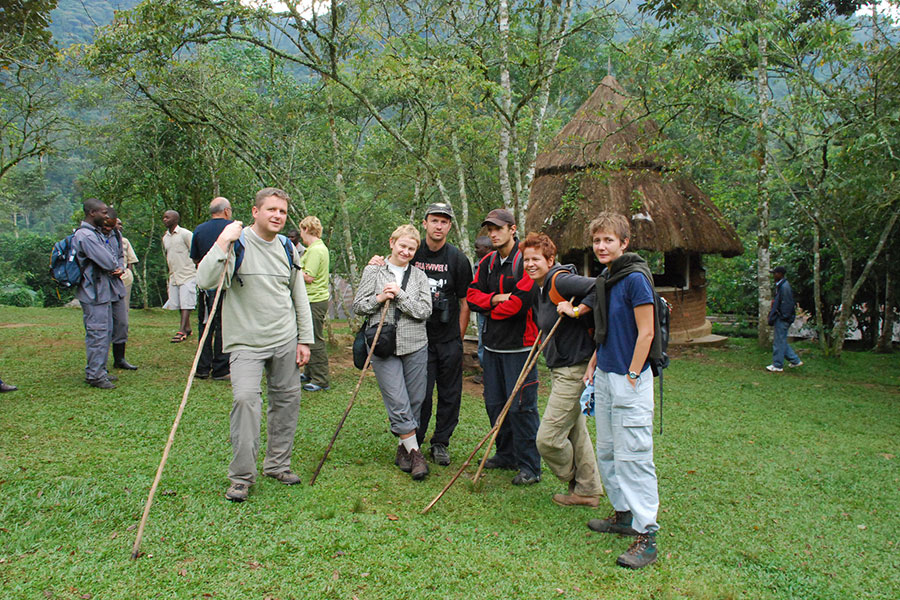Gorilla Trekking with Family, Children and Kids
Gorilla Trekking with Family, Children and Kids, trekking is a highly sought-after wildlife activity in Rwanda, Congo, and Uganda. Tourists are intrigued by the observation of wild mountain gorillas due to their human-like behavior and resemblance. Each mountain gorilla is valued at approximately 65,000 US Dollars when the annual revenue from gorilla licenses is divided by the number of habituated individuals. The financial benefits from tourism and their endangered status have compelled the three governments to protect them diligently.
Watching a family of mountain gorillas, guided by the dominant silverback, can evoke profound emotions, prompting many individuals to desire this experience with close family or friends. A normal gorilla family comprises 6 to 24 members led by a dominant silverback. The silverback has strong protective instincts towards his family while also demonstrating affection towards the younger members. A normal gorilla group comprises females, adolescents, and newborns, occasionally including twins. Observing a bunch of mountain gorillas would be exceptional when conducted with family. Regrettably, this is not consistently true, particularly when it pertains to children.
Reasons children are prohibited from participating in gorilla trekking
The wildlife authorities in Uganda, Congo, and Rwanda have established the minimum age for gorilla trekking at 15 years. This indicates that children are prohibited from participating in gorilla trekking. Children may struggle to maintain composure when confronted by a charging gorilla. Mountain gorillas infrequently charge; nonetheless, they may do so if they perceive trackers as a threat. A charging gorilla will retreat if a tracker maintains composure and remains concealed. A kid may get excessively frightened, scream, or be compelled to flee due to the formidable roar of a gorilla. A charging gorilla will invariably pursue a fleeing visitor.
Family gorilla trekking Children are still cultivating their immunity and are susceptible to communicable infections such as influenza and cough. Influenza and cough can be transmitted to gorillas, resulting in potentially fatal consequences. Children exhibit unpredictability. They may be unable to complete the exercise if they feel fatigued. This is particularly applicable to Volcanoes National Park in Rwanda and Mgahinga National Park in Uganda. Gorilla trekking necessitates a certain degree of physical fitness and resolve to persevere until completion. In Rwanda, navigating hillsides and steep inclines can be arduous, particularly if a specific gorilla group is situated far from the starting location. Experienced travelers exhibit more focus and mental preparedness to confront the problems of gorilla tracking, including steep inclines, muddy paths, insects, and dense forests.
Gorilla Trekking with Family, Children and Kids, Children are less inclined to adhere to regulations for gorilla trekking. The regulations for gorilla trekking are designed to safeguard both the primates and the trackers. These entail maintaining a distance of no less than 7 meters, according to directives from the park guides, refraining from littering, conversing in subdued tones, avoiding direct eye contact with gorillas, and abstaining from any attempts to touch a gorilla.
Guidelines for Gorilla Trekking with Children
Although there are age restrictions for gorilla trekking, it still feasible to undertake the activity with children. A child aged 14 and nearing 15 may still be permitted to engage in gorilla trekking in Bwindi National Park, Uganda. Simply compose a letter to the Uganda Wildlife Authority, including details such as the age and photographs of the child. The parent must assume responsibility should any incidents occur throughout the expedition. The child is permitted to track the gorillas solely when accompanied by the adult in the same group. If you possess a 14-year-old child and intend to engage in gorilla trekking, please reach out to info@gorillatrekkinginafrica.com. We will assist you in obtaining special authorization for the youngster.
If a youngster is evidently too young for gorilla trekking, you may still travel with them, particularly if you have reservations for other wildlife activities. During your gorilla trekking excursion, hotel personnel can supervise the children and keep them occupied while you explore the forest. Children can engage in various activities while their parents participate in gorilla trekking. The hotel personnel or corporate guide can escort them on nature hikes, visit local schools, or attend traditional dance performances. The nature walks are conducted by a seasoned park guide to observe uncommon birds and butterflies. Parents may alternate tracking the primates while one stays behind to care for the youngsters for the day.

